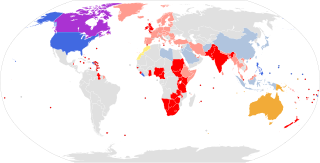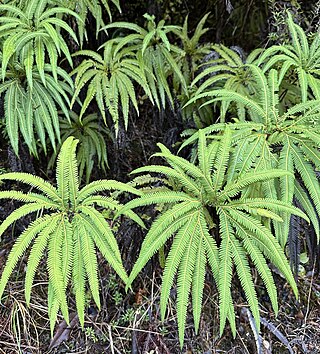Spelling is a set of conventions that regulate the way of using graphemes to represent a language in its written form. In other words, spelling is the rendering of speech sound (phoneme) into writing (grapheme). Spelling is one of the elements of orthography, and highly standardized spelling is a prescriptive element.

Adiantum, the maidenhair fern, is a genus of about 250 species of ferns in the subfamily Vittarioideae of the family Pteridaceae, though some researchers place it in its own family, Adiantaceae. The genus name comes from Greek, meaning "unwetted", referring to the fronds' ability to shed water without becoming wet.

The Tasmanian temperate rain forests are a temperate broadleaf and mixed forests ecoregion in western Tasmania. The ecoregion is part of the Australasian realm, which includes Tasmania and Australia, New Zealand, New Guinea, New Caledonia, and adjacent islands.
For centuries, there have been movements to reform the spelling of the English language. It seeks to change English orthography so that it is more consistent, matches pronunciation better, and follows the alphabetic principle. Common motives for spelling reform include quicker learning, cheaper learning, and making English more useful as an international auxiliary language.

Araucaria cunninghamii is a species of Araucaria known as hoop pine. Other less commonly used names include colonial pine, Queensland pine, Dorrigo pine, Moreton Bay pine and Richmond River pine. The scientific name honours the botanist and explorer Allan Cunningham, who collected the first specimens in the 1820s.

Despite the various English dialects spoken from country to country and within different regions of the same country, there are only slight regional variations in English orthography, the two most notable variations being British and American spelling. Many of the differences between American and British/Commonwealth English date back to a time before spelling standards were developed. For instance, some spellings seen as "American" today were once commonly used in Britain, and some spellings seen as "British" were once commonly used in the United States.
In biology, within the science of scientific nomenclature, i.e. the naming of organisms, an orthographical variant in botany or an orthographic error in zoology, is a spelling mistake, typing mistake or writing mistake within a scientific publication that resulted in a somewhat different name being accidentally used for an already-named organism. The rules that govern what to do when this happens are laid out in the relevant codes of nomenclature.

A conserved name or nomen conservandum is a scientific name that has specific nomenclatural protection. That is, the name is retained, even though it violates one or more rules which would otherwise prevent it from being legitimate. Nomen conservandum is a Latin term, meaning "a name to be conserved". The terms are often used interchangeably, such as by the International Code of Nomenclature for Algae, Fungi, and Plants (ICN), while the International Code of Zoological Nomenclature favours the term "conserved name".

Alsophila cunninghamii, synonym Cyathea cunninghamii, also known as the gully tree fern and slender tree fern, is a species of tree fern indigenous to New Zealand including North Island, South Island and Chatham Islands; also to Victoria, possibly New South Wales, southeastern Queensland and Tasmania in Australia. It grows in damp forest, often emerging from stream gullies and riverbanks. Brownsey noted that it has a lower tolerance for drought than other related species. The erect trunk may be 20 m tall and is usually 6–15 cm in diameter, occasionally as much as 20 cm. Fronds are tri- to tetrapinnate and 3 m or more in length. The rachis and stipe are slender, black brown, warty and covered with brown scales. Sori occur along each side of the pinnule midvein and are covered by hood-like indusia. A. cunninghamii is an uncommon and slow-growing tree fern.
Alsophila × marcescens, synonym Cyathea × marcescens, commonly known as the skirted tree fern, is a tree fern endemic to the Cape Otway ranges in Victoria and Tasmania, Australia. It is a natural hybrid, apparently Alsophila australis × Alsophila cunninghamii. Large and Braggins (2004) note that it has characteristics midway between these two species. The spores of A. × marcescens are usually malformed although sterile. The trunk of this plant is erect and up to 10 m tall. Fronds may be bi- or tripinnate and 3–4 m in length. Dead fronds often persist, forming a characteristic skirt around the trunk. The stipe is thick, black and warty. The rachis and trunk are covered in shiny, dark brown scales. Sori are borne near the fertile pinnule midvein and are protected by thin indusia that are saucer-like in appearance.

Plakobranchidae is a family of sea slugs, marine opisthobranch gastropod mollusks in the superfamily Plakobranchoidea. They superficially resemble nudibranchs but they are sacoglossans, members of the clade Sacoglossa within the Opisthobranchia.
Victoria, Australia contains approximately 32,000 hectares of temperate rainforest in various regions, which represents 0.14% of the State's total area. The areas with rainforest include: East Gippsland, Strzelecki Ranges, Wilsons Promontory, Central Highlands, and Otway Ranges. The rainforests vary between cool temperate, warm temperate, and mixed cool temperate.
In zoological nomenclature, an incorrect subsequent spelling is a name whose spelling has been unjustifiably and unintentionally changed from the original. It is distinct from a "mandatory change", a change to the original spelling that is required by the International Code of Zoological Nomenclature, and an "emendation", an intentional change to a name that may or may not be justified.

Adiantum cunninghamii is a maidenhair fern found in New Zealand. The sori are found under the curved leaf margins.

Sticherus cunninghamii, also known as umbrella fern, is a New Zealand endemic fern.

Emma Jones was a New Zealand author, amateur fern collector and painter. She is known for collecting a small number of fern specimens in New Zealand, which were used by Joseph Dalton Hooker in his Handbook of the New Zealand Flora.

Mentha cunninghamii, known commonly as New Zealand mint or Māori mint, is a species within the Mentha (mint) genus, endemic to New Zealand.
S. cunninghamii may refer to:











